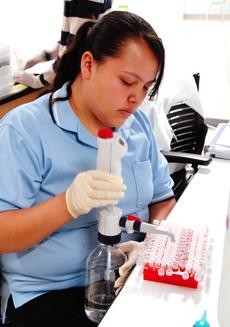When you buy a steak at the grocery store, you generally believe that what you’re paying for really came from a cow. But for meat consumers in the West African nation of Cameroon, the odds aren’t as good.
As sales of the illegally harvested mystery meat known as “”bushmeat”” rise in that country, genetics researchers at the UA are working on a program that could curb the trade and help provide sustainable solutions to the people who depend on it for their livelihood.
“”If I find bushmeat in a market, you don’t even know what it is sometimes because it’s just a piece of meat, right? With DNA you can actually identify the species,”” said Hans-Werner Herrmann, principal investigator for the Bushmeat Genotyping Project and assistant staff scientist at Arizona Research Laboratories.
The bushmeat found in big markets, such as in the capital city of Yaoundé, originates in tiny forest villages, Herrmann said.
The Bushmeat Project aims to use cutting-edge genotyping technology to create a bushmeat database so that a piece of meat found in a big market can be traced back to its source population. Then, those populations will be genetically monitored to evaluate whether they are sustainably harvestable or not, Herrmann said.
“”Instead of just allowing everything, and then a lot of species go extinct, or let’s prohibit everything and people starve and don’t see why when certain species are really common,”” Herrmann said, “”we want to look at it in an academic way, or a scientific way, and really understand what’s going on, for the benefit of the people and the animals.””
Last week, Herrmann was in Cameroon vying for funding for the project. He plans to seek $1.5 million from the United Nations and $300,000 worth of supplies from Cameroon; but this, he says, is only a start.
“”Bushmeat is not a Cameroonian problem. It’s a problem for all of western and central Africa,”” Herrman said.
Other groups have compiled bushmeat databases in the past, Herrmann said, but what is unique about this project is the “”monitoring step,”” where the health of a species will be monitored so that informed decisions can be made about hunting regulations.
“”That will give us an impression of how big the population is, the trend,”” Herrmann said. “”What is happening in the population – are we losing genetic diversity, or is it like a balance, or gaining?””
Taylor Edwards, an assistant staff scientist at ARL, said there might be some surprises when the genetic data is used to compare bushmeat markets to actual populations, but ascertaining the real situation is what the project is all about.
“”It could be that common things are common and rare things are rare, but it could be the other way around,”” Edwards said. “”It’s all speculation and anecdotal at this point.””
The project will proceed in three stages, Herrmann said. The first stage will be to build a database of bushmeat samples by starting in big markets and collecting samples there and along traffic routes back to the forest villages.
This first stage will require researchers to compare the DNA sequences of their samples at one specific mitochondrial gene, or “”locus.””
By comparing and contrasting these sequences, they will be able to group samples into not only species, but specific geographic populations. Individuals of the same species will have more genes in common with those from their own populations. This process is known as “”barcoding.””
In the second stage, the genetic information will be used to draw a map of population locations and trafficking routes.
“”Then if you find a piece of meat in a big market, 500 km away or even farther, we can assign that sample to a source population,”” Herrmann said. “”So we can actually say, yeah, that comes from there.””
But the third stage of the project is what Herrmann calls “”a really new challenge.”” It will involve taking new bushmeat samples over a period of time to monitor the health of a population. If genetic diversity in the population increases or stays the same, then the population is not adversely affected by harvesting.
However, if genetic diversity decreases, “”a red flag comes up, and we would have to say ‘Oh,’ like they do (in Arizona) with deer, hold off, let’s don’t give out any hunting permits this year,”” Herrmann said.
Herrmann is confident the project will lead to more responsible action both by government regulators and individual hunters.
“”It’s an ongoing effort,”” Herrmann said. “”Once we start this, we’re going to monitor and maybe include more populations in other countries, and that really allows us to see what’s going on with those wildlife populations. Can we sustainably harvest them? If we can, then we can actually find like a good legal source for income for the local population.””









